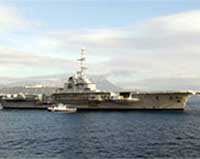Egypt awaits French ship assurances
France's decommissioned aircraft carrier Clemenceau has laid at anchor off the Egyptian coast waiting for Paris to give assurances to Cairo that the vessel is not an environmental hazard.
by Aljazeera.net (Qatar)
 |
 |
 |
 |
| |
 |
|
| |
The former warship's asbestos insulation is a cause for concern |
|
 |
 |
 |
 |
 |
 |
| |
 |
|
| |
The Clemenceau was used
in the 1991 Gulf War |
|
 |
 |
 |
|
| |
13 January 2006 – A former pride of the French navy, the 265-metre ship floating in the Mediterranean is destined for a scrapyard in India after leaving the coast off Toulon on 31 December.
Its asbestos insulation has provoked controversy over its transit and the health of Indian workers who will dismantle it.
A source with the authority was quoted as saying by Egypt's official Mena news agency: "The (Suez Canal) Authority requires certificates proving that the ship meets environmental standards for passing through the canal."
The source denied on Friday that Egypt had not allowed the Clemenceau to transit the Suez Canal.
Mena said: "The authority is not preventing any ship from transiting the canal but those transporting scrap metal must meet internationally agreed conditions to protect the environment."
French denial
In Paris on Thursday, the Defence Ministry denied that the warship, which is being towed under French navy escort, had been officially refused access by Egypt, but acknowledged that it had been asked for more information.
Jean-Francois Bureau, the ministry spokesman, said: "We are being asked for extra technical information, which we are in the process of providing.
"We have not been notified of a refusal decision at this point."
However, Mohammed Sayyed Khalil, the head of Egypt's environmental agency, said on Thursday that Cairo wanted written proof that the former aircraft carrier was not carrying hazardous waste in violation of the Basel Convention banning such trade.
He said: "We have decided to prohibit the Clemenceau from entering Egypt's territorial waters."
Khalil said Egypt had "not been informed officially of the transit request until the beginning of the week, and without the documents needed from the French and Indian Environment Ministries".
On Friday, a French diplomatic source told AFP in Cairo: "Contacts continue with the Egyptian authorities to complete (canal) transit procedures."
The French Defence Ministry said the Clemenceau - now just consisting of the ship's hull - was not, as a former warship, considered scrap.
Toxic poisoning
The dispatch of the Clemenceau by the French government to Shree Ram Scrap Vessel breakers' yard in Gujarat, west India, some 40 years after entering service, has sparked fierce controversy in both countries.
Critics accuse Paris of dumping its toxic waste on the Third World.
Two Greenpeace protesters, who had boarded the ship as it was being towed in international waters, have left by their own accord.
Greenpeace has been fighting to block the ship's transfer for months, arguing that Indian shipyard workers will be at risk of asbestos poisoning.
Martin Besieux, the movement's spokesman in Cairo, said the Indian Supreme Court would begin examining the request for the ship's entry into Indian waters from Monday after a panel temporarily blocked it on 6 January.
But he said the hearings would continue past 20 January when a committee of experts is due to hear arguments from all parties.
Poor preparation
The warship, which took part in the 1991 Gulf War, was taken out of service in 1997 when it was superseded by France's nuclear-powered aircraft carrier, the Charles de Gaulle.
Egyptian maritime officials said the voyage via the Suez Canal had been poorly prepared.
A Port Said agent, said: "The French had said it was only a civilian vessel, leaving it also too late to carry out the necessary procedure through a private transit agency."
According to the French government, the vessel is carrying 45 tonnes of asbestos insulation. According to the firm that helped partially decontaminate it before the trip, the amount is between 500 and 1000 tonnes.
FAIR USE NOTICE. This document contains copyrighted material whose use has not been specifically authorized by the copyright owner. The Basel Action Network is making this article available in our efforts to advance understanding of ecological sustainability and environmental justice issues. We believe that this constitutes a 'fair use' of the copyrighted material as provided for in section 107 of the US Copyright Law. If you wish to use this copyrighted material for purposes of your own that go beyond 'fair use', you must obtain permission from the copyright owner.
More News
|